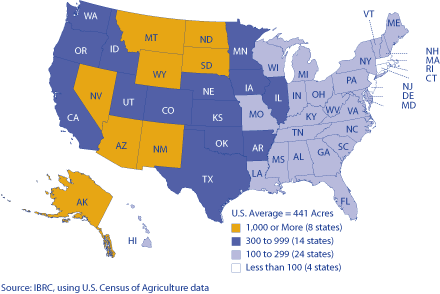Farming for Data: Agriculture in Indiana
In light of the 2007 Census of Agriculture approaching in December (the law requires every farmer and rancher to participate), it seems appropriate to highlight some of the useful data this census provides. Let's take a look at just some of the things we learned from the 2002 agriculture census.
The number of farms in the United States is on the rise: there were 2.1 million farms in 2002, up from 1.9 million in 1997. These farms covered more than 938 million acres of land (an increase of 6.5 million in five years). Only about 46 percent of that land was covered by crops, a percent that has remained fairly steady over that time frame.
Smaller farms are growing at a faster rate than the large ones. Farms covering one to 49 acres of land increased by about 32 percent from 1997 to 2002. Meanwhile, the number of farms covering 180 to 499 acres and 500 to 999 acres decreased by more than 14,000 each. Farms with more than 1,000 acres of land saw a slight increase, adding 910 to the count since 1997 (see Figure 1).
Figure 1: Number of Farms by Size in Indiana
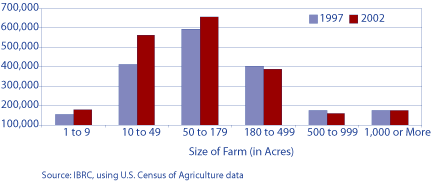
Farms by State
Texas led the United States in number of farms, reporting nearly 229,000 in 2002. Second-place Missouri trailed behind that figure with about 107,000 farms. Indiana ranked 13th among the 50 states. Rhode Island and Alaska had the fewest number of farms, each with less than 1,000 (see Figure 2).
Figure 2: Number of Farms by State, 2002
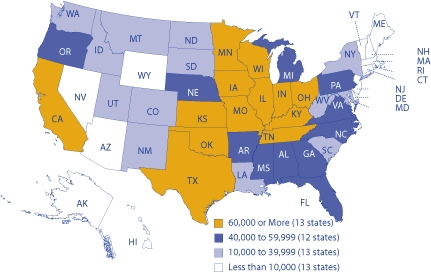
Click for larger image Looking at the average size of farms across the states tells a different story. The United States averaged 441 acres of land per farm. Indiana was well below that average coming in 26th with an average of 250 acres per farm. Part of this is likely due to the fact that there is simply more land area available in the western states. The states with the largest farms included Wyoming and Arizona. Not only did Rhode Island have very few farms, it also had very small farms, averaging 71 acres per farm (see Figure 3).
Figure 3: Average Size of Farms by State, 2002
Indiana's Farming Counties
Let's dig deeper into Indiana's counties to find out which ones can be classified as farm counties vs. nonfarm counties. We will then look at more recent data for comparison. For the purposes of this article, a farming county is defined as one in which at least 25 percent of its farms have sales of at least $100,000, the highest classification offered for counties by the Census of Agriculture. Twenty-two of Indiana's 92 counties meet these criteria (see Figure 4). Benton County led the state on this measure, with more than half of its 394 farms producing at least $100,000 in sales. Of the farming counties, Vermillion had the fewest farms numerically with at least $100,000 in sales, reporting 57 farms meeting the criteria. At the other end of the spectrum, Jasper County had the most numerically with 240 of its 641 farms falling into that category.
Figure 4: Indiana's Farm Counties, 2002
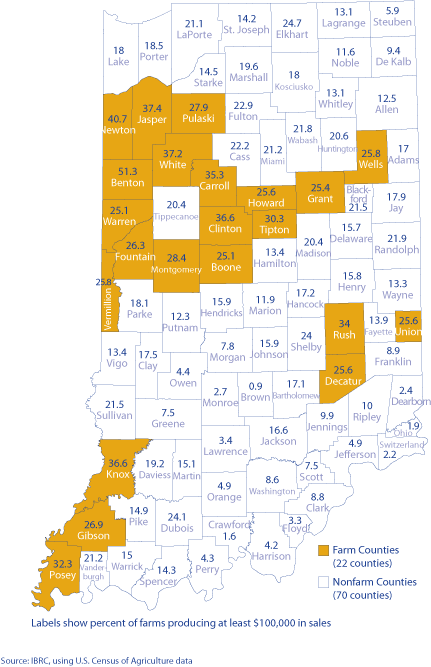
Farm Counties vs. Nonfarm Counties
As a result of the nature of farms and the amount of land they require, it is not surprising that farm counties made up about 24.3 percent of land area in Indiana in 2006, while the population residing on that land only accounted for 10 percent of Hoosiers, down from 10.2 percent in 2001. This decrease is a result of the population of farm counties growing at a slower rate than the population of nonfarm counties, 0.6 percent growth compared to 3.3 percent growth, respectively.
Industry Employment
It can be expected that farm counties have a greater proportion of workers employed farming, but what percentage of total employment do those workers actually make up? According to the latest data available from the Bureau of Labor Statistics, the agriculture, forestry, fishing and hunting industry comprised 0.3 percent of all jobs in nonfarm counties in the second quarter of 2006; that number was 1.6 percent of total employment in farm counties. Nonfarm counties actually lost jobs in the agriculture, forestry, fishing and hunting industry, down 0.7 percent from the second quarter of 2001. Meanwhile, farm counties added 130 jobs in the industry. However, other industry sectors did not fare so well in the farm counties. Percent change in total jobs from 2001 to 2006 in farm counties was -1.3 percent, whereas nonfarm counties increased employment across all industry sectors by 0.8 percent (see Table 1).
Table 1: Jobs in Nonfarm and Farm Counties in Indiana, 2001:2 to 2006:2
| Industry | Nonfarm Counties |
Farm Counties |
||||
2006:2 |
Change Since 2001:2 |
Percent Change |
2006:2 |
Change Since 2001:2 |
Percent Change |
|
| Total | 2,598,696 | 21,296 | 0.8 | 241,152 | -3,296 | -1.3 |
| Management of Companies and Enterprises | 22,849 | 671 | 3.0 | 276 | 99 | 55.9 |
| Administrative, Support and Waste Management | 138,364 | 22,306 | 19.2 | 9,831 | 1,842 | 23.1 |
| Professional, Scientific and Technical Services | 82,117 | 3,463 | 4.4 | 4,944 | 620 | 14.3 |
| Transportation and Warehousing | 113,879 | -2,403 | -2.1 | 11,152 | 1,366 | 14.0 |
| Educational Services | 199,401 | 2,100 | 1.1 | 21,064 | 1,740 | 9.0 |
| Health Care and Social Services | 320,225 | 32,431 | 11.3 | 27,226 | 1,929 | 7.6 |
| Construction | 136,622 | 1,390 | 1.0 | 10,827 | 600 | 5.9 |
| Wholesale Trade | 104,206 | -1,113 | -1.1 | 7,640 | 419 | 5.8 |
| Agriculture, Forestry, Fishing and Hunting | 7,298 | -50 | -0.7 | 3,879 | 130 | 3.5 |
| Arts, Entertainment and Recreation | 37,110 | 198 | 0.5 | 1,957 | 50 | 2.6 |
| Public Administration | 117,920 | 4,311 | 3.8 | 11,213 | 286 | 2.6 |
| Accommodation and Food Services | 216,822 | 16,057 | 8.0 | 17,811 | -156 | -0.9 |
| Finance and Insurance | 92,175 | -5,883 | -6.0 | 5,221 | -118 | -2.2 |
| Mining | 3,088 | -1,352 | -30.5 | 795 | -30 | -3.6 |
| Utilities | 11,708 | 160 | 1.4 | 1,269 | -48 | -3.6 |
| Other Services (Except Public Administration) | 78,218 | -1,182 | -1.5 | 5,888 | -353 | -5.7 |
| Retail Trade | 293,095 | -13,998 | -4.6 | 26,287 | -2,685 | -9.3 |
| Manufacturing | 502,071 | -48,171 | -8.8 | 65,724 | -7,937 | -10.8 |
| Information | 42,956 | -4,616 | -9.7 | 2,793 | -360 | -11.4 |
| Real Estate, Rental and Leasing | 34,830 | 1,031 | 3.1 | 1,715 | -267 | -13.5 |
Industry Wages
Given the definition of farm counties, it makes sense that they pay higher wages in the agriculture, forestry, fishing and hunting industry than do nonfarm counties ($542 per week compared to $477 per week). However, as is true with jobs, overall average weekly wages are higher for nonfarm counties ($683 per week versus $668 per week). Figure 5 shows the average weekly wages for farm vs. nonfarm counties.
Figure 5: Average Weekly Wages for Nonfarm and Farm Counties in Indiana, 2006:
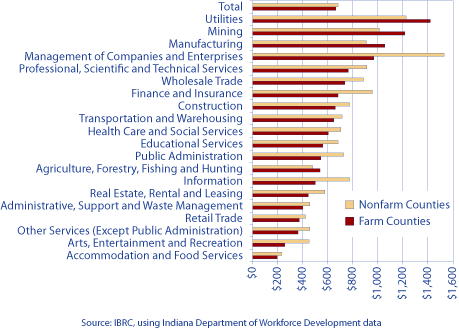
Conclusion
The number of farms and the amount of land covered by farms changed in the United States from 1997 to 2002, and it is likely that more changes have occurred in the past five years. Have more farms emerged? Has the average size of farms decreased? The results of the upcoming Census of Agriculture should give us insight into these questions and can serve as a starting point in determining how farm and nonfarm counties compare demographically and economically in Indiana and across the United States. To learn more about the Census of Agriculture and how to participate, visit www.agcensus.usda.gov/About_the_Census/index.asp.
Molly Manns
Associate Editor, Indiana Business Research Center, Kelley School of Business, Indiana University

